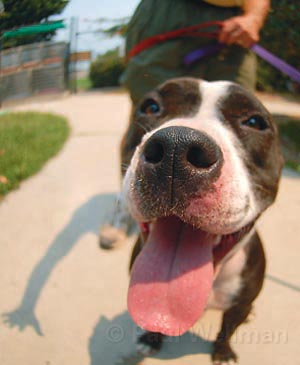Animal Shelters Are Bursting with Abandoned Pit Bulls

Of the 45 dogs available for adoption at the Santa Barbara County Public Health Department’s (SBCPHD) Animal Shelter, 15 are pit bulls or pit-bull mixes. Like a MySpace page for pooches, each dog has its own photo and profile on the shelter’s Web site (k-9pals.org). Take Abby, for example, a caramel brown two-year-old female: “This sweet, submissive little girl wants to be your baby.” Or Donut, a female black-and-white pup who is “extremely fun and loves to romp and play.” As their eyes stare longingly from the screen, it is hard to imagine why so many of these beautiful dogs were surrendered or left stray.
Unlike humans, these dogs cannot send potential owners an email to arrange a first date and explain why they ended up alone. Instead, the story of why they arrived at the shelter is a mystery and the dogs are left to rely on the kindness of volunteers and animal services workers to provide food, training, and care. However, after so many dogs of the same breed have arrived at the shelter, Jan Glick, the animal services director at the SBCPHD Animal Shelter, has developed some explanations.
First off, there is the allure of the breed’s popularity, Glick said. But after getting their new pit bull home, she said some owners might realize their new Fido is “more dog than they signed up for.” Then the overwhelmed new owners abandon the dogs at the shelter or let them go stray. To make matters worse, Glick said, the pit bulls might remain at the shelter for a long time, unadopted. “There are not a lot of people who are willing to adopt that [breed of] dog,” said Glick.
According to Glick, part of the reason pit bulls remain at the shelter longer is they’re one of several “power breeds,” or dogs that were at some point bred for animal aggression. Some other power breeds include rottweilers, chow chows, and sharpeis. Dogs that fall into that power breed category are more difficult to match with new owners, as compared to stray terriers, collies, or poodles. Luckily, the Santa Barbara shelter has a no-kill policy for dogs deemed “adoptable” and a friendly pit bull can remain there indefinitely until it is matched up with an appropriate new owner.
There is also the problem of unscrupulous backyard pit bull breeders who are trying to sell the dogs to make a quick buck or to raise the pups for dog fighting. Glick cited a recent animal cruelty and dog-fighting incident in the area involving an eight-week-old brindled pit bull puppy. The dog, which was picked up by S.B. Animal Control officers in late July, was found with its ears raggedly cut off, an injury associated with dog fighting. A hearing was held for the puppy’s owners, but they never showed. Glick said the puppy “will be okay” and is receiving care at the shelter. Eventually, the dog will be adoptable.
Glick said the story of the pit bull puppy serves as a reminder that cruelty to animals and dog fighting are both illegal. But there was a time when owners could match two dogs against each other, taking a cut of the bets placed on the outcome. According to Bay Area Dog Lovers Responsible About Pit Bulls (BAD RAP), a nonprofit organization for pit bull owners, rescuers, and supporters, American pit bull terriers were developed in the British Isles in the 1800s to bait bulls, a popular spectator sport at the time. When that was abolished, dog fighting gained popularity and pit bulls began to be bred to attack other dogs.
But BAD RAP’s Web site (www.badrap.org) states it was also important to early breeders that the dogs not bite humans, and, as a result, many modern pit bulls retain an uncommon friendliness and loyalty toward their owners. The site also gives examples of how in the early 20th century pit bulls were seen as the all-American dog. For instance, the Little Rascals’ dog, Petey, was a pit bull (with an iconic circle always painted over one eye), and the canine pal for shoe company Buster Brown was also a pit bull.
The dog’s reputation first became tarnished in the 1980s, when the breed became associated with urban crime and illegal dog-fighting rings, according to BAD RAP. That trend continues today, as proven by the earless puppy found here last month. Janelle Ward, founder and president of K-9 Placement and Assistance League (K-9 PALS), a volunteer organization that provides care for the dogs at the county shelter, places the blame for any of the recent dog fighting and shelter overcrowding problems on reckless pit bull breeders. “When you see a large number of unwanted dogs of a certain breed type [at shelters] you know they are being carelessly bred and sold, most likely for a quick profit, with no concern as to what will happen to the dogs,” said Ward.
While the overabundance of pit bulls at the county shelter is worrisome, it is good news for those who are willing to give pit bulls a chance (and who have the time, space, and appropriate dog enclosure). After all, there are many different rescued pit bulls to choose from in the county shelter, and all pit bulls adopted there are spayed or neutered. According to Ward, a good pit bull owner must be able to provide the dog with a lot of training and they must be able to take charge. Ward also said, “Pit bulls are usually not good with other animals.” For the right owner, the breed can make the perfect pooch. As Ward said, “Pit bulls are very affectionate and loyal.”



